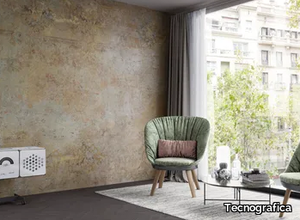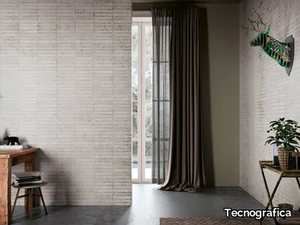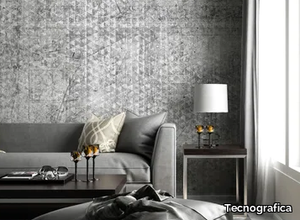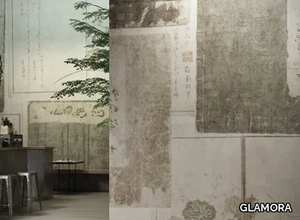CARPETEC MG transition trims for carpet floors
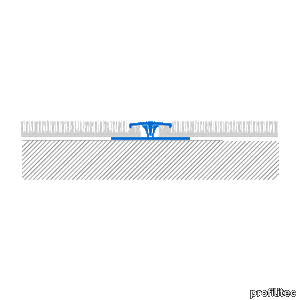
profilitec > Accessories
CARPETEC MG transition trims for carpet floors Designed for carpet flooring, CARPETEC MG profiles are composed of two elements: a base track onto which the carpet is laid, and an interlocking, grooved top piece that snaps shut and compresses the carpeting.
CARPETEC MP Transition / edging trims for carpet floors
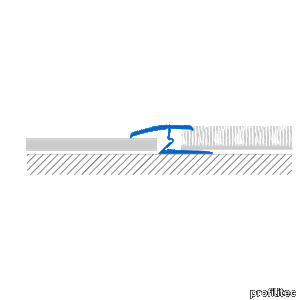
profilitec > Accessories
CARPETEC MP Transition / edging trims for carpet floors The multipurpose, grooved moquetteEC MP profiles designed to compress moquette flooring at different elevations. They may be used to join two types of moquetteing or as edge profiles.
CARPETEC MS edging tims for carpet floors
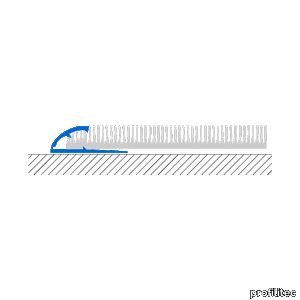
profilitec > Accessories
CARPETEC MS edging tims for carpet floors Rounded perimeter profile in anodised aluminium or brass for flexible floors such as moquetteing and coconut mats. The profiles, by pressing them, close, locking the coating in a lasting way, covering the cutting defects and preserving the edge. The profile is serrated both in the rounded part on the inside and on the surface to allow a better grip of the moquette.
CARPTEC MA edging tims for carpet floors

profilitec > Accessories
CARPTEC MA edging tims for carpet floors perimeter profiles in anodised aluminium for flexible floors such as moquettes and coconut mats. The profiles, by pressing them, close, locking the moquette in a lasting way, covering the cutting defects and preserving the edge. The profile has hooks both in the rounded part on the inside and on the surface to allow a better grip of the moquette.
CARPETEC MD edging tims for carpet floors

profilitec > Accessories
CARPETEC MD edging tims for carpet floors Perimeter profiles in anodised aluminium for flexible floors such as moquettes and coconut mats. The profiles, by pressing them, close, locking the edge, covering the cutting defects and preserving the edge. Available in the perforated and with hooks version to allow a better grip of the moquette.
Quaderna 150
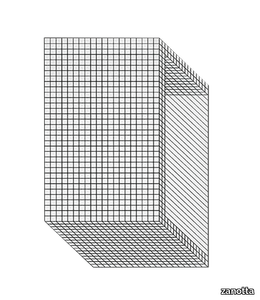
zanotta > Styling
Carpet. Hand-tufted carpet with uniform fleece over the entire surface made of 100% New Zealand wool. Lower support in 100% cotton canvas fixed with 100% natural latex glue. Perimeter edging finished by hand with wool thread on all six sides. Available in sizes 200x300 cm and 250x350 cm in a single colour scheme: white background and gray and black lines compliant with the original design. Carpet thickness - 9 mm and weight -3.7 Kg / square meter.
Setu Graphite/Graphite Office Chair
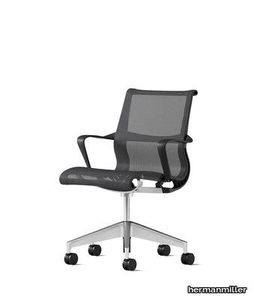
hermanmiller > Office Chair
Description A unique combination of flexibility and strength meet the demands of more collaborative workplaces while the dematerialised spine bends and flexes as you do. Features Kinematic Spine Lyris 2 Suspension One adjustment for height Combined hard floor and carpet castors Overall Dimensions (mm) 980 mm (h) x 638 mm (w) x 381 mm (d) Max Capacity (kg) 136kg Product Weight (kg) 8.6kg Assembly Comes fully assembled Warranty 12-year
LEVELTEC RP Transition trims to be used after flooring installation

profilitec > Accessories
LEVELTEC RP Transition trims to be used after flooring installation LEVELTEC RP is a series of profiles with a terminal or connecting function between floors of different nature and thickness. These profiles also cover any chipping of the ceramic edge and imperfect cuts of wood or carpet floors. The LEVELTEC RP series consists of profiles with heights between 4.5 ÷ 12.5 mm, capable of compensating for height differences of 3 ÷ 14 mm. The profile is normally supplied with adhesive of high sealing properties. They are also available in a drilled version for fixing with screws and dowels. LEVELTEC RP: transition profile in different dimensions Smooth and grooved LEVELTEC profiles in varying widths and heights transition floors of different elevations. Their sectional thickness makes them especially suitable for high traffic areas and the end detailing allows frictionless contact between the profile and floor. LEVELTEC RP how to install Installation of self-adhesive version: 1) Make sure the base is solid, flat, level, clean, and dry. 2) Cut the profile to the desired length and remove adhesive backing. 3) Press uniformly downwards on to the profile to apply. Do not hammer. Installation of pre-drilled version: 1) Cut the profile to the desired length and mark the position of the pre-drilled holes. 2) Fasten with flathead screws.
New York Sedia Dining Arm Chair, Linen

abchome > Armchair
<!-- td {border: 1px solid #cccccc;}br {mso-data-placement:same-cell;} --> Handmade in Italy and exclusively at abc carpet & home, the Sedia arm dining chair counterpoints a cotton/linen slipcover with a sleek chrome finish. The tidy geometric form is softened by a padded seat and tonal tufting on the back. Complete with a removable slipcover for easy cleaning or changing up your look, this piece makes light work of dining and entertaining.
D_Segni Colore
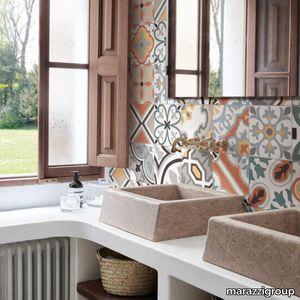
marazzigroup > Floor tile-stone
Coloured Stoneware Cement Tiles D_Segni Colore comes in three solid-colour powdery shades. Four different decorative elements and a decoration consisting of 15 carpet patterns enrich this collection of colourful cement tiles.
Arazzi
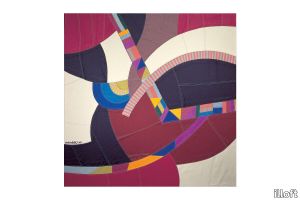
illoft > Styling
An innovative tufting technique that is based on ancient hand knotting methods, without trimming so that the wool is left at two different heights on the surface, thereby ensuring exceptional softness when the carpet is touched and walked on. This craftman's technique, which is carried out entirely by hand, gives the carpet an immensely pleasing image of the ancient textile art that existed before carpets were trimmed to a uniform level.
Setu Alpine/Studio White Office Chair
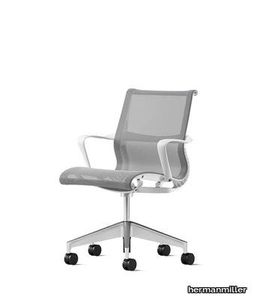
hermanmiller > Office Chair
Description A unique combination of flexibility and strength meet the demands of more collaborative workplaces while the dematerialised spine bends and flexes as you do. Features Kinematic Spine Lyris 2 Suspension One adjustment for height Combined hard floor and carpet castors Overall Dimensions (mm) 980 mm (h) x 638 mm (w) x 381 mm (d) Max Capacity (kg) 136kg Product Weight (kg) 8.6kg Assembly Comes fully assembled Warranty 12-year
Cosm Nightfall/Nightfall High Back Office Chair
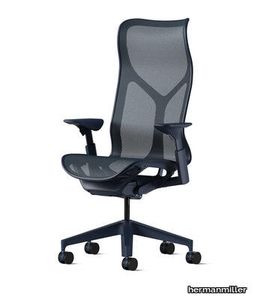
hermanmiller > Office Chair
Description Cosm responds automatically to your body's movements and provides total support for whatever postures you find yourself in throughout the day. Available in high, mid and low back options , three distinct arm styles and your choice of one top-to-bottom dipped-in-colour hue, Cosm is where performance meets beauty. Features 12-year warranty Auto-Harmonic™ tilt mechanism automatically adjusts A minimum user-weight of 55kg (120lbs) is required to activate the recline One adjustment for height Continuous and breathable seat and back Combined hard floor and carpet castors Overall Dimensions (mm) Low Back: 1031 (h) x 734 (w) x 678 (d)Mid Back: 1156 (h) x 734 (w) x 678 (d)High Back: 1311 (h) x 734 (w) x 678 (d) Max Capacity (kg) Low Back: 159Mid Back: 159 High Back: 159 Product Weight (kg) Low Back: 15.5 Mid Back: 15.8High Back: 16.1 Assembly Comes fully assembled Warranty 12-year
Cosm Graphite/Graphite High Back Office Chair

hermanmiller > Office Chair
Description Cosm responds automatically to your body's movements and provides total support for whatever postures you find yourself in throughout the day. Available in high, mid and low back options , three distinct arm styles and your choice of one top-to-bottom dipped-in-colour hue, Cosm is where performance meets beauty. Features 12-year warranty Auto-Harmonic™ tilt mechanism automatically adjusts A minimum user-weight of 55kg (120lbs) is required to activate the recline One adjustment for height Continuous and breathable seat and back Combined hard floor and carpet castors Overall Dimensions (mm) Low Back: 1031 (h) x 734 (w) x 678 (d)Mid Back: 1156 (h) x 734 (w) x 678 (d)High Back: 1311 (h) x 734 (w) x 678 (d) Max Capacity (kg) Low Back: 159Mid Back: 159 High Back: 159 Product Weight (kg) Low Back: 15.5 Mid Back: 15.8High Back: 16.1 Assembly Comes fully assembled Warranty 12-year
Tesori Broccato grigio
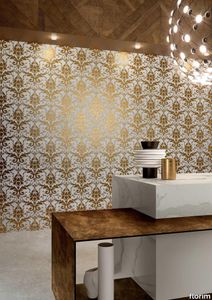
florim > Wallcovering
East and West, a synthesis archieved through Italian taste. «My work often takes me to far-off lands, also remote in terms of their culture and traditions. Even without my being aware of it, I then metabolise these traditions and include them in the designs I subsequently produce.» Matteo Nunziati <p>"It is the architect's task to create a warm, livable space. Carpets are warm and livable. He decides for this reason to spread one carpet on the floor and to hang up four to form the four walls. But you cannot build a house out of carpets. Both the carpet and the floor and the tapestry on the wall required structural frame to hold them in the correct place. To invent this frame is the architect's second task."When Adolf Loos wrote his revolutionary essay on the "principle of cladding" in 1898, architecture was just entering the modern age. Building meant imagining structures capable of putting together different materials, but, Loos affirmed, it must also respect their individual characteristics. "Every material possesses a formal language which belongs to it alone and no material can take on the forms proper to another", the Austrian master therefore maintained. And there is no doubt that the spirit of these words extended throughout most Twentieth Century architecture, regardless of its location or style. When we look at Matteo Nunziati's designs for the CEDIT Tesori collection, we seem to be seeing geometrical purity and attention to detail at the service of a new "truth" of material. Because Matteo Nunziati views ceramics as a form of fabric.<br /> The woven patterns he imagines for the various styles in his collection "“ from Arabian to damask to more geometrical motifs "“ constantly seek to provide the soft, iridescent look of time-worn linen. In them, ceramics are raised from the status of poor relation of marble to become a luxury wall covering in their own right: almost a wallpaper, suitable however for both floors and walls, and an absolutely versatile material. No longer only for beautifying bathrooms, they can create new moods in every room of the house (and elsewhere) starting from the living-room. Naturally, the revolution has been mainly technological. The large slabs produced by CEDIT are more than 3 metres tall, and since they eliminate the serial repetition typical of conventional tiles, they generate a new relationship between the surface and its decoration. However, Nunziati does not use this to create, artist-like, a more eye-catching decorative composition that emphasises the slab's dimensions. Quite the opposite; the patterns he offers us attempt to break down what is left of the boundaries between substrates. In particular, the Arabian and damask styles, in the version with "timeworn" patterning, convey the idea of the ceramic slab as an abstract, almost non-existent material which melts into the decorative motif applied to it, in a kind of pure wall covering.<br /> Through the patient selection of geometrical motifs and tests to verify their suitability for application to ceramic slabs, Nunziati aims to achieve a new material rather than a mere decoration, making this clear by also exploring its tactile dimension, with gouged and relief motifs. His "principle of coverings" therefore relates to ceramics' essence rather than their image: highlighting the versatility which, as we all know, has made ceramics an absolute material, a kind of cement that incorporates structure and finish in a virtually infinite range of applications. This is clearly indicated by the reference to the mashrabiya, a term meaning place where people drink in Arabic, which in Arabian architecture originally referred to the kind of veranda where people used to meet and rest, and over time has come to mean the wooden gratings that screened these places from the sun. Inspired by his trips to the Middle East, for Nunziati the geometric patterns of the mashrabiya become both an outline of his method of work and the form of what in fact becomes the key element in a new idea of space: a real location conceived around a strong, livable surface in which physical substance and decoration overlap to the point where they merge.</p>
D_Segni

marazzigroup > Floor tile-stone
Handmade Stoneware Cementine Micro, macro, geometric, floral, classical, vintage, metropolitan: the new D_Segni collection uses a mix of inputs in a stoneware reinterpretation of Italy’s lovely traditional hand-made cement tiles, in the small 20x20 cm size. 7 warm and cold colours and 19 different patterns make up the Mix Carpet, the most daring decorative feature, alongside the micro and macro versions of the traditional floral and geometrical cement tile motifs, updated with a sharper, more contemporary ‘take’ on the product, which makes it extremely versatile.
Mirra 2 Twilight/Studio White Butterfly Office Chair

hermanmiller > Office Chair
Description The secret of the Mirra 2 Chair is that it intuitively mirrors your natural movements, like a good running shoe. So for all you rockers, foot tappers and side leaners, this is the chair for you. Feel free to stretch, reach and change posture. Mirra 2 can keep up. Features 12-year warranty Adjustable lumbar support Fully adjustable arms Flex front adjustable seat Tilt limiter and forward tilt Combined hard floor and carpet castors Overall Dimensions (mm) 1111 mm (h) x 762 mm (w) x 470 mm (d) Max Capacity (kg) 159kg Product Weight (kg) 15.9kg Assembly Comes fully assembled Warranty 12-year
Tesori Lino bianco

florim > Wallcovering
East and West, a synthesis archieved through Italian taste. «My work often takes me to far-off lands, also remote in terms of their culture and traditions. Even without my being aware of it, I then metabolise these traditions and include them in the designs I subsequently produce.» Matteo Nunziati <p>"It is the architect's task to create a warm, livable space. Carpets are warm and livable. He decides for this reason to spread one carpet on the floor and to hang up four to form the four walls. But you cannot build a house out of carpets. Both the carpet and the floor and the tapestry on the wall required structural frame to hold them in the correct place. To invent this frame is the architect's second task."When Adolf Loos wrote his revolutionary essay on the "principle of cladding" in 1898, architecture was just entering the modern age. Building meant imagining structures capable of putting together different materials, but, Loos affirmed, it must also respect their individual characteristics. "Every material possesses a formal language which belongs to it alone and no material can take on the forms proper to another", the Austrian master therefore maintained. And there is no doubt that the spirit of these words extended throughout most Twentieth Century architecture, regardless of its location or style. When we look at Matteo Nunziati's designs for the CEDIT Tesori collection, we seem to be seeing geometrical purity and attention to detail at the service of a new "truth" of material. Because Matteo Nunziati views ceramics as a form of fabric.<br /> The woven patterns he imagines for the various styles in his collection "“ from Arabian to damask to more geometrical motifs "“ constantly seek to provide the soft, iridescent look of time-worn linen. In them, ceramics are raised from the status of poor relation of marble to become a luxury wall covering in their own right: almost a wallpaper, suitable however for both floors and walls, and an absolutely versatile material. No longer only for beautifying bathrooms, they can create new moods in every room of the house (and elsewhere) starting from the living-room. Naturally, the revolution has been mainly technological. The large slabs produced by CEDIT are more than 3 metres tall, and since they eliminate the serial repetition typical of conventional tiles, they generate a new relationship between the surface and its decoration. However, Nunziati does not use this to create, artist-like, a more eye-catching decorative composition that emphasises the slab's dimensions. Quite the opposite; the patterns he offers us attempt to break down what is left of the boundaries between substrates. In particular, the Arabian and damask styles, in the version with "timeworn" patterning, convey the idea of the ceramic slab as an abstract, almost non-existent material which melts into the decorative motif applied to it, in a kind of pure wall covering.<br /> Through the patient selection of geometrical motifs and tests to verify their suitability for application to ceramic slabs, Nunziati aims to achieve a new material rather than a mere decoration, making this clear by also exploring its tactile dimension, with gouged and relief motifs. His "principle of coverings" therefore relates to ceramics' essence rather than their image: highlighting the versatility which, as we all know, has made ceramics an absolute material, a kind of cement that incorporates structure and finish in a virtually infinite range of applications. This is clearly indicated by the reference to the mashrabiya, a term meaning place where people drink in Arabic, which in Arabian architecture originally referred to the kind of veranda where people used to meet and rest, and over time has come to mean the wooden gratings that screened these places from the sun. Inspired by his trips to the Middle East, for Nunziati the geometric patterns of the mashrabiya become both an outline of his method of work and the form of what in fact becomes the key element in a new idea of space: a real location conceived around a strong, livable surface in which physical substance and decoration overlap to the point where they merge.</p>
Tesori Broccato bianco

florim > Wallcovering
East and West, a synthesis archieved through Italian taste. «My work often takes me to far-off lands, also remote in terms of their culture and traditions. Even without my being aware of it, I then metabolise these traditions and include them in the designs I subsequently produce.» Matteo Nunziati <p>"It is the architect's task to create a warm, livable space. Carpets are warm and livable. He decides for this reason to spread one carpet on the floor and to hang up four to form the four walls. But you cannot build a house out of carpets. Both the carpet and the floor and the tapestry on the wall required structural frame to hold them in the correct place. To invent this frame is the architect's second task."When Adolf Loos wrote his revolutionary essay on the "principle of cladding" in 1898, architecture was just entering the modern age. Building meant imagining structures capable of putting together different materials, but, Loos affirmed, it must also respect their individual characteristics. "Every material possesses a formal language which belongs to it alone and no material can take on the forms proper to another", the Austrian master therefore maintained. And there is no doubt that the spirit of these words extended throughout most Twentieth Century architecture, regardless of its location or style. When we look at Matteo Nunziati's designs for the CEDIT Tesori collection, we seem to be seeing geometrical purity and attention to detail at the service of a new "truth" of material. Because Matteo Nunziati views ceramics as a form of fabric.<br /> The woven patterns he imagines for the various styles in his collection "“ from Arabian to damask to more geometrical motifs "“ constantly seek to provide the soft, iridescent look of time-worn linen. In them, ceramics are raised from the status of poor relation of marble to become a luxury wall covering in their own right: almost a wallpaper, suitable however for both floors and walls, and an absolutely versatile material. No longer only for beautifying bathrooms, they can create new moods in every room of the house (and elsewhere) starting from the living-room. Naturally, the revolution has been mainly technological. The large slabs produced by CEDIT are more than 3 metres tall, and since they eliminate the serial repetition typical of conventional tiles, they generate a new relationship between the surface and its decoration. However, Nunziati does not use this to create, artist-like, a more eye-catching decorative composition that emphasises the slab's dimensions. Quite the opposite; the patterns he offers us attempt to break down what is left of the boundaries between substrates. In particular, the Arabian and damask styles, in the version with "timeworn" patterning, convey the idea of the ceramic slab as an abstract, almost non-existent material which melts into the decorative motif applied to it, in a kind of pure wall covering.<br /> Through the patient selection of geometrical motifs and tests to verify their suitability for application to ceramic slabs, Nunziati aims to achieve a new material rather than a mere decoration, making this clear by also exploring its tactile dimension, with gouged and relief motifs. His "principle of coverings" therefore relates to ceramics' essence rather than their image: highlighting the versatility which, as we all know, has made ceramics an absolute material, a kind of cement that incorporates structure and finish in a virtually infinite range of applications. This is clearly indicated by the reference to the mashrabiya, a term meaning place where people drink in Arabic, which in Arabian architecture originally referred to the kind of veranda where people used to meet and rest, and over time has come to mean the wooden gratings that screened these places from the sun. Inspired by his trips to the Middle East, for Nunziati the geometric patterns of the mashrabiya become both an outline of his method of work and the form of what in fact becomes the key element in a new idea of space: a real location conceived around a strong, livable surface in which physical substance and decoration overlap to the point where they merge.</p>
Tesori Lino grigio

florim > Wallcovering
East and West, a synthesis archieved through Italian taste. «My work often takes me to far-off lands, also remote in terms of their culture and traditions. Even without my being aware of it, I then metabolise these traditions and include them in the designs I subsequently produce.» Matteo Nunziati <p>"It is the architect's task to create a warm, livable space. Carpets are warm and livable. He decides for this reason to spread one carpet on the floor and to hang up four to form the four walls. But you cannot build a house out of carpets. Both the carpet and the floor and the tapestry on the wall required structural frame to hold them in the correct place. To invent this frame is the architect's second task."When Adolf Loos wrote his revolutionary essay on the "principle of cladding" in 1898, architecture was just entering the modern age. Building meant imagining structures capable of putting together different materials, but, Loos affirmed, it must also respect their individual characteristics. "Every material possesses a formal language which belongs to it alone and no material can take on the forms proper to another", the Austrian master therefore maintained. And there is no doubt that the spirit of these words extended throughout most Twentieth Century architecture, regardless of its location or style. When we look at Matteo Nunziati's designs for the CEDIT Tesori collection, we seem to be seeing geometrical purity and attention to detail at the service of a new "truth" of material. Because Matteo Nunziati views ceramics as a form of fabric.<br /> The woven patterns he imagines for the various styles in his collection "“ from Arabian to damask to more geometrical motifs "“ constantly seek to provide the soft, iridescent look of time-worn linen. In them, ceramics are raised from the status of poor relation of marble to become a luxury wall covering in their own right: almost a wallpaper, suitable however for both floors and walls, and an absolutely versatile material. No longer only for beautifying bathrooms, they can create new moods in every room of the house (and elsewhere) starting from the living-room. Naturally, the revolution has been mainly technological. The large slabs produced by CEDIT are more than 3 metres tall, and since they eliminate the serial repetition typical of conventional tiles, they generate a new relationship between the surface and its decoration. However, Nunziati does not use this to create, artist-like, a more eye-catching decorative composition that emphasises the slab's dimensions. Quite the opposite; the patterns he offers us attempt to break down what is left of the boundaries between substrates. In particular, the Arabian and damask styles, in the version with "timeworn" patterning, convey the idea of the ceramic slab as an abstract, almost non-existent material which melts into the decorative motif applied to it, in a kind of pure wall covering.<br /> Through the patient selection of geometrical motifs and tests to verify their suitability for application to ceramic slabs, Nunziati aims to achieve a new material rather than a mere decoration, making this clear by also exploring its tactile dimension, with gouged and relief motifs. His "principle of coverings" therefore relates to ceramics' essence rather than their image: highlighting the versatility which, as we all know, has made ceramics an absolute material, a kind of cement that incorporates structure and finish in a virtually infinite range of applications. This is clearly indicated by the reference to the mashrabiya, a term meaning place where people drink in Arabic, which in Arabian architecture originally referred to the kind of veranda where people used to meet and rest, and over time has come to mean the wooden gratings that screened these places from the sun. Inspired by his trips to the Middle East, for Nunziati the geometric patterns of the mashrabiya become both an outline of his method of work and the form of what in fact becomes the key element in a new idea of space: a real location conceived around a strong, livable surface in which physical substance and decoration overlap to the point where they merge.</p>
Mirra 2 Graphite/Graphite Butterfly Office Chair
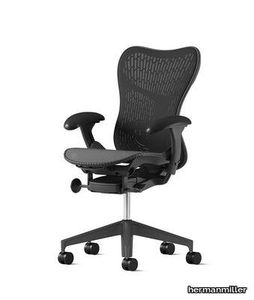
hermanmiller > Office Chair
Description The secret of the Mirra 2 Chair is that it intuitively mirrors your natural movements, like a good running shoe. So for all you rockers, foot tappers and side leaners, this is the chair for you. Feel free to stretch, reach and change posture. Mirra 2 can keep up. Features 12-year warranty Adjustable lumbar support Fully adjustable arms Flex front adjustable seat Tilt limiter and forward tilt Combined hard floor and carpet castors Overall Dimensions (mm) 1111 mm (h) x 762 mm (w) x 470 mm (d) Max Capacity (kg) 159kg Product Weight (kg) 15.9kg Assembly Comes fully assembled Warranty 12-year
Mirra 2 Butterfly Office Chair
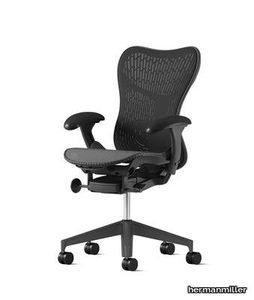
hermanmiller > Office Chair
Description The secret of the Mirra 2 Chair is that it intuitively mirrors your natural movements, like a good running shoe. So for all you rockers, foot tappers and side leaners, this is the chair for you. Feel free to stretch, reach and change posture. Mirra 2 can keep up. Features 12-year warranty Adjustable lumbar support Fully adjustable arms Flex front adjustable seat Tilt limiter and forward tilt Combined hard floor and carpet castors Overall Dimensions (mm) 1111 mm (h) x 762 mm (w) x 470 mm (d) Max Capacity (kg) 159kg Product Weight (kg) 15.9kg Assembly Comes fully assembled Warranty 12-year
Shard Wall Sconce

abchome > Wall lamp
Experience the elegance of the Shard Wall Sconce, a beautifully crafted lighting piece enclosed in a sleek antique brass frame. Its frosted panels emit a soft glow, adding a touch of ambiance to any space. A perfect balance of simplicity and sophistication. All Pooky lighting is exclusively available in the U.S. at abc carpet & home. Originally launched in the UK, Pooky is all about bringing the magic of stunning, decorative lighting to your home.
Mirra 2 Twilight/Studio White Triflex Office Chair

hermanmiller > Office Chair
Description The secret of the Mirra 2 Chair is that it intuitively mirrors your natural movements, like a good running shoe. So for all you rockers, foot tappers and side leaners, this is the chair for you. Feel free to stretch, reach and change posture. Mirra 2 can keep up. Features 12-year warranty Adjustable lumbar support Fully adjustable arms Flex front adjustable seat Tilt limiter and forward tilt Combined hard floor and carpet castors Overall Dimensions (mm) 1111 mm (h) x 762 mm (w) x 470 mm (d) Max Capacity (kg) 159kg Product Weight (kg) 15.9kg Assembly Comes fully assembled Warranty 12-year
Cosm High Back Office Chair
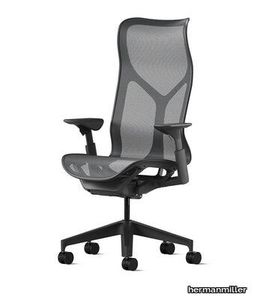
hermanmiller > Office Chair
Description Cosm responds automatically to your body's movements and provides total support for whatever postures you find yourself in throughout the day. Available in high, mid and low back options , three distinct arm styles and your choice of one top-to-bottom dipped-in-colour hue, Cosm is where performance meets beauty. Features 12-year warranty Auto-Harmonic™ tilt mechanism automatically adjusts A minimum user-weight of 55kg (120lbs) is required to activate the recline One adjustment for height Continuous and breathable seat and back Combined hard floor and carpet castors Overall Dimensions (mm) Low Back: 1031 (h) x 734 (w) x 678 (d)Mid Back: 1156 (h) x 734 (w) x 678 (d)High Back: 1311 (h) x 734 (w) x 678 (d) Max Capacity (kg) Low Back: 159Mid Back: 159 High Back: 159 Product Weight (kg) Low Back: 15.5 Mid Back: 15.8High Back: 16.1 Assembly Comes fully assembled Warranty 12-year
FRINGES
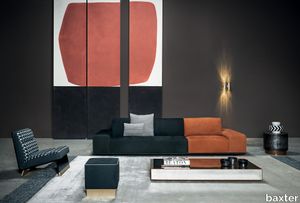
baxter > Accessories
Craft rug made on wooden looms, made up of a mix of naturally occurring silks, obtained from plants, among which soy, banana tree and bamboo. For the routine maintenance of the carpets, we suggest to vacuum them, in order to remove dust and other residues. It might happen that, during a first period, some fibres come off from the carpet. This is absolutely normal. The wool and/or silk carpets always have some excess fibres, which disappear gradually with the normal use. In order to get a uniform exposure to light and to trampling, we suggest to rotate the carpet regularly. We also recommend removing stains immediately. Proceed with caution in order not to damage the fibres. To remove stains, soak up first of all with blotting paper. Then immerse a cloth or a sponge in lukewarm water. Dampen the stain without rubbing and soak up, repeating these actions until you have completely removed the stain. For difficult stains, we recommend promptly contacting specialist dry-cleaner’s shops. For the washing, we recommend contacting specialist dry-cleaner’s shops.
Cosm Graphite/Graphite High Back Office Chair
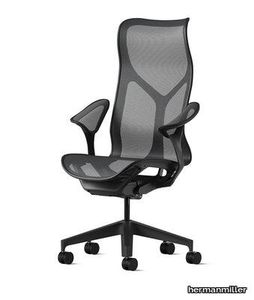
hermanmiller > Office Chair
Description Cosm responds automatically to your body's movements and provides total support for whatever postures you find yourself in throughout the day. Available in high, mid and low back options , three distinct arm styles and your choice of one top-to-bottom dipped-in-colour hue, Cosm is where performance meets beauty. Features 12-year warranty Auto-Harmonic™ tilt mechanism automatically adjusts A minimum user-weight of 55kg (120lbs) is required to activate the recline One adjustment for height Continuous and breathable seat and back Combined hard floor and carpet castors Overall Dimensions (mm) Low Back: 1031 (h) x 734 (w) x 678 (d)Mid Back: 1156 (h) x 734 (w) x 678 (d)High Back: 1311 (h) x 734 (w) x 678 (d) Max Capacity (kg) Low Back: 159Mid Back: 159 High Back: 159 Product Weight (kg) Low Back: 15.5 Mid Back: 15.8High Back: 16.1 Assembly Comes fully assembled Warranty 12-year
Cosm Mid Back Office Chair
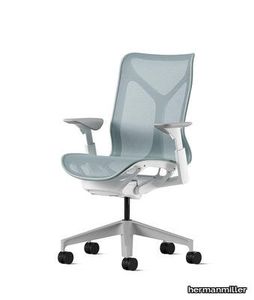
hermanmiller > Office Chair
Description Cosm responds automatically to your body's movements and provides total support for whatever postures you find yourself in throughout the day. Available in high, mid and low back options , three distinct arm styles and your choice of one top-to-bottom dipped-in-colour hue, Cosm is where performance meets beauty. Features 12-year warranty Auto-Harmonic™ tilt mechanism automatically adjusts A minimum user-weight of 55kg (120lbs) is required to activate the recline One adjustment for height Continuous and breathable seat and back Combined hard floor and carpet castors Overall Dimensions (mm) Low Back: 1031 (h) x 734 (w) x 678 (d)Mid Back: 1156 (h) x 734 (w) x 678 (d)High Back: 1311 (h) x 734 (w) x 678 (d) Max Capacity (kg) Low Back: 159Mid Back: 159 High Back: 159 Product Weight (kg) Low Back: 15.5 Mid Back: 15.8High Back: 16.1 Assembly Comes fully assembled Warranty 12-year
Mirra 2 Alpine/Studio White Butterfly Office Chair

hermanmiller > Office Chair
Description The secret of the Mirra 2 Chair is that it intuitively mirrors your natural movements, like a good running shoe. So for all you rockers, foot tappers and side leaners, this is the chair for you. Feel free to stretch, reach and change posture. Mirra 2 can keep up. Features 12-year warranty Adjustable lumbar support Fully adjustable arms Flex front adjustable seat Tilt limiter and forward tilt Combined hard floor and carpet castors Overall Dimensions (mm) 1111 mm (h) x 762 mm (w) x 470 mm (d) Max Capacity (kg) 159kg Product Weight (kg) 15.9kg Assembly Comes fully assembled Warranty 12-year
Tesori Anelli grigio

florim > Wallcovering
East and West, a synthesis archieved through Italian taste. «My work often takes me to far-off lands, also remote in terms of their culture and traditions. Even without my being aware of it, I then metabolise these traditions and include them in the designs I subsequently produce.» Matteo Nunziati <p>"It is the architect's task to create a warm, livable space. Carpets are warm and livable. He decides for this reason to spread one carpet on the floor and to hang up four to form the four walls. But you cannot build a house out of carpets. Both the carpet and the floor and the tapestry on the wall required structural frame to hold them in the correct place. To invent this frame is the architect's second task."When Adolf Loos wrote his revolutionary essay on the "principle of cladding" in 1898, architecture was just entering the modern age. Building meant imagining structures capable of putting together different materials, but, Loos affirmed, it must also respect their individual characteristics. "Every material possesses a formal language which belongs to it alone and no material can take on the forms proper to another", the Austrian master therefore maintained. And there is no doubt that the spirit of these words extended throughout most Twentieth Century architecture, regardless of its location or style. When we look at Matteo Nunziati's designs for the CEDIT Tesori collection, we seem to be seeing geometrical purity and attention to detail at the service of a new "truth" of material. Because Matteo Nunziati views ceramics as a form of fabric.<br /> The woven patterns he imagines for the various styles in his collection "“ from Arabian to damask to more geometrical motifs "“ constantly seek to provide the soft, iridescent look of time-worn linen. In them, ceramics are raised from the status of poor relation of marble to become a luxury wall covering in their own right: almost a wallpaper, suitable however for both floors and walls, and an absolutely versatile material. No longer only for beautifying bathrooms, they can create new moods in every room of the house (and elsewhere) starting from the living-room. Naturally, the revolution has been mainly technological. The large slabs produced by CEDIT are more than 3 metres tall, and since they eliminate the serial repetition typical of conventional tiles, they generate a new relationship between the surface and its decoration. However, Nunziati does not use this to create, artist-like, a more eye-catching decorative composition that emphasises the slab's dimensions. Quite the opposite; the patterns he offers us attempt to break down what is left of the boundaries between substrates. In particular, the Arabian and damask styles, in the version with "timeworn" patterning, convey the idea of the ceramic slab as an abstract, almost non-existent material which melts into the decorative motif applied to it, in a kind of pure wall covering.<br /> Through the patient selection of geometrical motifs and tests to verify their suitability for application to ceramic slabs, Nunziati aims to achieve a new material rather than a mere decoration, making this clear by also exploring its tactile dimension, with gouged and relief motifs. His "principle of coverings" therefore relates to ceramics' essence rather than their image: highlighting the versatility which, as we all know, has made ceramics an absolute material, a kind of cement that incorporates structure and finish in a virtually infinite range of applications. This is clearly indicated by the reference to the mashrabiya, a term meaning place where people drink in Arabic, which in Arabian architecture originally referred to the kind of veranda where people used to meet and rest, and over time has come to mean the wooden gratings that screened these places from the sun. Inspired by his trips to the Middle East, for Nunziati the geometric patterns of the mashrabiya become both an outline of his method of work and the form of what in fact becomes the key element in a new idea of space: a real location conceived around a strong, livable surface in which physical substance and decoration overlap to the point where they merge.</p>
Tesori Anelli bianco

florim > Wallcovering
East and West, a synthesis archieved through Italian taste. «My work often takes me to far-off lands, also remote in terms of their culture and traditions. Even without my being aware of it, I then metabolise these traditions and include them in the designs I subsequently produce.» Matteo Nunziati <p>"It is the architect's task to create a warm, livable space. Carpets are warm and livable. He decides for this reason to spread one carpet on the floor and to hang up four to form the four walls. But you cannot build a house out of carpets. Both the carpet and the floor and the tapestry on the wall required structural frame to hold them in the correct place. To invent this frame is the architect's second task."When Adolf Loos wrote his revolutionary essay on the "principle of cladding" in 1898, architecture was just entering the modern age. Building meant imagining structures capable of putting together different materials, but, Loos affirmed, it must also respect their individual characteristics. "Every material possesses a formal language which belongs to it alone and no material can take on the forms proper to another", the Austrian master therefore maintained. And there is no doubt that the spirit of these words extended throughout most Twentieth Century architecture, regardless of its location or style. When we look at Matteo Nunziati's designs for the CEDIT Tesori collection, we seem to be seeing geometrical purity and attention to detail at the service of a new "truth" of material. Because Matteo Nunziati views ceramics as a form of fabric.<br /> The woven patterns he imagines for the various styles in his collection "“ from Arabian to damask to more geometrical motifs "“ constantly seek to provide the soft, iridescent look of time-worn linen. In them, ceramics are raised from the status of poor relation of marble to become a luxury wall covering in their own right: almost a wallpaper, suitable however for both floors and walls, and an absolutely versatile material. No longer only for beautifying bathrooms, they can create new moods in every room of the house (and elsewhere) starting from the living-room. Naturally, the revolution has been mainly technological. The large slabs produced by CEDIT are more than 3 metres tall, and since they eliminate the serial repetition typical of conventional tiles, they generate a new relationship between the surface and its decoration. However, Nunziati does not use this to create, artist-like, a more eye-catching decorative composition that emphasises the slab's dimensions. Quite the opposite; the patterns he offers us attempt to break down what is left of the boundaries between substrates. In particular, the Arabian and damask styles, in the version with "timeworn" patterning, convey the idea of the ceramic slab as an abstract, almost non-existent material which melts into the decorative motif applied to it, in a kind of pure wall covering.<br /> Through the patient selection of geometrical motifs and tests to verify their suitability for application to ceramic slabs, Nunziati aims to achieve a new material rather than a mere decoration, making this clear by also exploring its tactile dimension, with gouged and relief motifs. His "principle of coverings" therefore relates to ceramics' essence rather than their image: highlighting the versatility which, as we all know, has made ceramics an absolute material, a kind of cement that incorporates structure and finish in a virtually infinite range of applications. This is clearly indicated by the reference to the mashrabiya, a term meaning place where people drink in Arabic, which in Arabian architecture originally referred to the kind of veranda where people used to meet and rest, and over time has come to mean the wooden gratings that screened these places from the sun. Inspired by his trips to the Middle East, for Nunziati the geometric patterns of the mashrabiya become both an outline of his method of work and the form of what in fact becomes the key element in a new idea of space: a real location conceived around a strong, livable surface in which physical substance and decoration overlap to the point where they merge.</p>
Cosm Low Back Office Chair
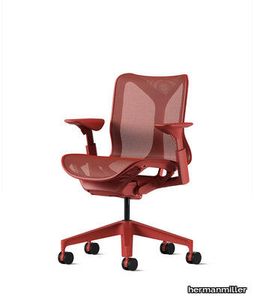
hermanmiller > Office Chair
Description Cosm responds automatically to your body's movements and provides total support for whatever postures you find yourself in throughout the day. Available in high, mid and low back options , three distinct arm styles and your choice of one top-to-bottom dipped-in-colour hue, Cosm is where performance meets beauty. Features 12-year warranty Auto-Harmonic™ tilt mechanism automatically adjusts A minimum user-weight of 55kg (120lbs) is required to activate the recline One adjustment for height Continuous and breathable seat and back Combined hard floor and carpet castors Overall Dimensions (mm) Low Back: 1031 (h) x 734 (w) x 678 (d)Mid Back: 1156 (h) x 734 (w) x 678 (d)High Back: 1311 (h) x 734 (w) x 678 (d) Max Capacity (kg) Low Back: 159Mid Back: 159 High Back: 159 Product Weight (kg) Low Back: 15.5 Mid Back: 15.8High Back: 16.1 Assembly Comes fully assembled Warranty 12-year
Dioré

arte-international > Wallcovering
Dioré is a wonderful print on a high-pile textile. It is a contemporary, more abstract interpretation of classic tapestries. Thanks to the high quality of the textile and the colour nuances in the design, this wallcovering can barely be distinguished from a hand-tufted carpet. The design owes its name to the protected Forêt de Dioré on the island of Réunion.
Odin Chandelier

abchome > Ceiling lamp
The grand and magnificent Odin Chandelier is crafted from 400 glass rods around a double tier of antiqued brass, imposing and very stylish all at the same time. Make a statement in any space as the centerpiece of the room. All Pooky lighting is exclusively available in the U.S. at abc carpet & home. Originally launched in the UK, Pooky is all about bringing the magic of stunning, decorative lighting to your home. Note: self-assembly required. If you were tasked with making over the banqueting halls in Valhalla then maybe this could be the kind of vibe you’d be after. We’ve scaled it down to fit more earthly dwellings but it still has over 400 glass rods around a double tier of brass and is grand, imposing and very stylish all at the same time. A magnificent centrepiece over a dining table or a kitchen island. A show-stealer, no mistake. Comes with a certain level of self-assembly required.Dimensions: 39.25" W x 39.25" D x 11.75" H Brand: Pooky Category: Lighting Sub-Category: Lighting > Pendants + Chandeliers Specifications: Indoor use only Dimmerable Chain length 79" Minimum drop 17.75" Ceiling canopy diameter 5.5" Self assembly is required E26 Care: Gently dust with a soft cloth. Material: Glass
Mirra 2 Triflex Office Chair

hermanmiller > Office Chair
Description The secret of the Mirra 2 Chair is that it intuitively mirrors your natural movements, like a good running shoe. So for all you rockers, foot tappers and side leaners, this is the chair for you. Feel free to stretch, reach and change posture. Mirra 2 can keep up. Features 12-year warranty Adjustable lumbar support Fully adjustable arms Flex front adjustable seat Tilt limiter and forward tilt Combined hard floor and carpet castors Overall Dimensions (mm) 1111 mm (h) x 762 mm (w) x 470 mm (d) Max Capacity (kg) 159kg Product Weight (kg) 15.9kg Assembly Comes fully assembled Warranty 12-year
Cosm White/Nightfall High Back Office Chair
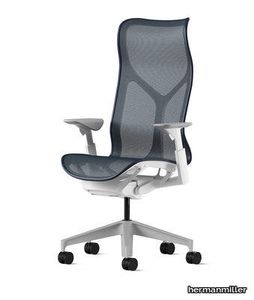
hermanmiller > Office Chair
Description Cosm responds automatically to your body's movements and provides total support for whatever postures you find yourself in throughout the day. Available in high, mid and low back options , three distinct arm styles and your choice of one top-to-bottom dipped-in-colour hue, Cosm is where performance meets beauty. Features 12-year warranty Auto-Harmonic™ tilt mechanism automatically adjusts A minimum user-weight of 55kg (120lbs) is required to activate the recline One adjustment for height Continuous and breathable seat and back Combined hard floor and carpet castors Overall Dimensions (mm) Low Back: 1031 (h) x 734 (w) x 678 (d)Mid Back: 1156 (h) x 734 (w) x 678 (d)High Back: 1311 (h) x 734 (w) x 678 (d) Max Capacity (kg) Low Back: 159Mid Back: 159 High Back: 159 Product Weight (kg) Low Back: 15.5 Mid Back: 15.8High Back: 16.1 Assembly Comes fully assembled Warranty 12-year
Tesori Monile bianco

florim > Wallcovering
East and West, a synthesis archieved through Italian taste. «My work often takes me to far-off lands, also remote in terms of their culture and traditions. Even without my being aware of it, I then metabolise these traditions and include them in the designs I subsequently produce.» Matteo Nunziati <p>"It is the architect's task to create a warm, livable space. Carpets are warm and livable. He decides for this reason to spread one carpet on the floor and to hang up four to form the four walls. But you cannot build a house out of carpets. Both the carpet and the floor and the tapestry on the wall required structural frame to hold them in the correct place. To invent this frame is the architect's second task."When Adolf Loos wrote his revolutionary essay on the "principle of cladding" in 1898, architecture was just entering the modern age. Building meant imagining structures capable of putting together different materials, but, Loos affirmed, it must also respect their individual characteristics. "Every material possesses a formal language which belongs to it alone and no material can take on the forms proper to another", the Austrian master therefore maintained. And there is no doubt that the spirit of these words extended throughout most Twentieth Century architecture, regardless of its location or style. When we look at Matteo Nunziati's designs for the CEDIT Tesori collection, we seem to be seeing geometrical purity and attention to detail at the service of a new "truth" of material. Because Matteo Nunziati views ceramics as a form of fabric.<br /> The woven patterns he imagines for the various styles in his collection "“ from Arabian to damask to more geometrical motifs "“ constantly seek to provide the soft, iridescent look of time-worn linen. In them, ceramics are raised from the status of poor relation of marble to become a luxury wall covering in their own right: almost a wallpaper, suitable however for both floors and walls, and an absolutely versatile material. No longer only for beautifying bathrooms, they can create new moods in every room of the house (and elsewhere) starting from the living-room. Naturally, the revolution has been mainly technological. The large slabs produced by CEDIT are more than 3 metres tall, and since they eliminate the serial repetition typical of conventional tiles, they generate a new relationship between the surface and its decoration. However, Nunziati does not use this to create, artist-like, a more eye-catching decorative composition that emphasises the slab's dimensions. Quite the opposite; the patterns he offers us attempt to break down what is left of the boundaries between substrates. In particular, the Arabian and damask styles, in the version with "timeworn" patterning, convey the idea of the ceramic slab as an abstract, almost non-existent material which melts into the decorative motif applied to it, in a kind of pure wall covering.<br /> Through the patient selection of geometrical motifs and tests to verify their suitability for application to ceramic slabs, Nunziati aims to achieve a new material rather than a mere decoration, making this clear by also exploring its tactile dimension, with gouged and relief motifs. His "principle of coverings" therefore relates to ceramics' essence rather than their image: highlighting the versatility which, as we all know, has made ceramics an absolute material, a kind of cement that incorporates structure and finish in a virtually infinite range of applications. This is clearly indicated by the reference to the mashrabiya, a term meaning place where people drink in Arabic, which in Arabian architecture originally referred to the kind of veranda where people used to meet and rest, and over time has come to mean the wooden gratings that screened these places from the sun. Inspired by his trips to the Middle East, for Nunziati the geometric patterns of the mashrabiya become both an outline of his method of work and the form of what in fact becomes the key element in a new idea of space: a real location conceived around a strong, livable surface in which physical substance and decoration overlap to the point where they merge.</p>
Tesori Monile grigio

florim > Wallcovering
East and West, a synthesis archieved through Italian taste. «My work often takes me to far-off lands, also remote in terms of their culture and traditions. Even without my being aware of it, I then metabolise these traditions and include them in the designs I subsequently produce.» Matteo Nunziati <p>"It is the architect's task to create a warm, livable space. Carpets are warm and livable. He decides for this reason to spread one carpet on the floor and to hang up four to form the four walls. But you cannot build a house out of carpets. Both the carpet and the floor and the tapestry on the wall required structural frame to hold them in the correct place. To invent this frame is the architect's second task."When Adolf Loos wrote his revolutionary essay on the "principle of cladding" in 1898, architecture was just entering the modern age. Building meant imagining structures capable of putting together different materials, but, Loos affirmed, it must also respect their individual characteristics. "Every material possesses a formal language which belongs to it alone and no material can take on the forms proper to another", the Austrian master therefore maintained. And there is no doubt that the spirit of these words extended throughout most Twentieth Century architecture, regardless of its location or style. When we look at Matteo Nunziati's designs for the CEDIT Tesori collection, we seem to be seeing geometrical purity and attention to detail at the service of a new "truth" of material. Because Matteo Nunziati views ceramics as a form of fabric.<br /> The woven patterns he imagines for the various styles in his collection "“ from Arabian to damask to more geometrical motifs "“ constantly seek to provide the soft, iridescent look of time-worn linen. In them, ceramics are raised from the status of poor relation of marble to become a luxury wall covering in their own right: almost a wallpaper, suitable however for both floors and walls, and an absolutely versatile material. No longer only for beautifying bathrooms, they can create new moods in every room of the house (and elsewhere) starting from the living-room. Naturally, the revolution has been mainly technological. The large slabs produced by CEDIT are more than 3 metres tall, and since they eliminate the serial repetition typical of conventional tiles, they generate a new relationship between the surface and its decoration. However, Nunziati does not use this to create, artist-like, a more eye-catching decorative composition that emphasises the slab's dimensions. Quite the opposite; the patterns he offers us attempt to break down what is left of the boundaries between substrates. In particular, the Arabian and damask styles, in the version with "timeworn" patterning, convey the idea of the ceramic slab as an abstract, almost non-existent material which melts into the decorative motif applied to it, in a kind of pure wall covering.<br /> Through the patient selection of geometrical motifs and tests to verify their suitability for application to ceramic slabs, Nunziati aims to achieve a new material rather than a mere decoration, making this clear by also exploring its tactile dimension, with gouged and relief motifs. His "principle of coverings" therefore relates to ceramics' essence rather than their image: highlighting the versatility which, as we all know, has made ceramics an absolute material, a kind of cement that incorporates structure and finish in a virtually infinite range of applications. This is clearly indicated by the reference to the mashrabiya, a term meaning place where people drink in Arabic, which in Arabian architecture originally referred to the kind of veranda where people used to meet and rest, and over time has come to mean the wooden gratings that screened these places from the sun. Inspired by his trips to the Middle East, for Nunziati the geometric patterns of the mashrabiya become both an outline of his method of work and the form of what in fact becomes the key element in a new idea of space: a real location conceived around a strong, livable surface in which physical substance and decoration overlap to the point where they merge.</p>
Mirra 2 Graphite/Graphite Triflex Office Chair
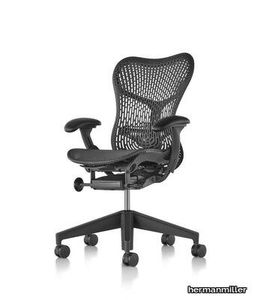
hermanmiller > Office Chair
Description The secret of the Mirra 2 Chair is that it intuitively mirrors your natural movements, like a good running shoe. So for all you rockers, foot tappers and side leaners, this is the chair for you. Feel free to stretch, reach and change posture. Mirra 2 can keep up. Features 12-year warranty Adjustable lumbar support Fully adjustable arms Flex front adjustable seat Tilt limiter and forward tilt Combined hard floor and carpet castors Overall Dimensions (mm) 1111 mm (h) x 762 mm (w) x 470 mm (d) Max Capacity (kg) 159kg Product Weight (kg) 15.9kg Assembly Comes fully assembled Warranty 12-year
Mirra 2 Turquoise/Studio White Triflex Office Chair
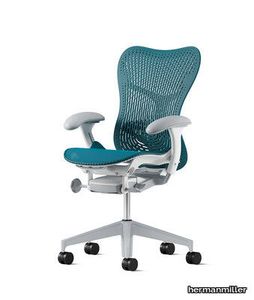
hermanmiller > Office Chair
Description The secret of the Mirra 2 Chair is that it intuitively mirrors your natural movements, like a good running shoe. So for all you rockers, foot tappers and side leaners, this is the chair for you. Feel free to stretch, reach and change posture. Mirra 2 can keep up. Features 12-year warranty Adjustable lumbar support Fully adjustable arms Flex front adjustable seat Tilt limiter and forward tilt Combined hard floor and carpet castors Overall Dimensions (mm) 1111 mm (h) x 762 mm (w) x 470 mm (d) Max Capacity (kg) 159kg Product Weight (kg) 15.9kg Assembly Comes fully assembled Warranty 12-year
BERBÈRE

baxter > Accessories
This rug is completely hand-knotted on traditional vertical looms in hand-spun wool, following the features of the Berber-Moroccan rugs of the beginning of ‘900. The finishing process is very elaborate: after the first shave and the handwash, every single rug is handled in order to create a unique product: a skilled craftsman works on the surface with scissors, in order to give it the typical irregularities of the original rugs. On one side a selvage is created, matching with the design pattern and decorated with a woolen stitching. On the other side, fringes are woven one by one, following the style of the old Berber rugs. The b/w version is carried out through the use of non-dyed wools, while the other versions involve the use of vegetable dyes. For the routine maintenance of the carpets, we suggest to vacuum them, in order to remove dust and other residues. It might happen that, during a first period, some fibres come off from the carpet. This is absolutely normal. The wool and/or silk carpets always have some excess fibres, which disappear gradually with the normal use. In order to get a uniform exposure to light and to trampling, we suggest to rotate the carpet regularly. We also recommend removing stains immediately. Proceed with caution in order not to damage the fibres. To remove stains, soak up first of all with blotting paper. Then immerse a cloth or a sponge in lukewarm water. Dampen the stain without rubbing and soak up, repeating these actions until you have completely removed the stain. For difficult stains, we recommend promptly contacting specialist dry-cleaner’s shops. For the washing, we recommend contacting specialist dry-cleaner’s shops.
Caret MF1
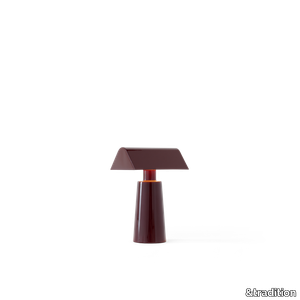
&tradition > Table lamp
A practical solution to the increasingly blurred boundaries between work and home, the portable Caret reimagines the linear silhouettes of the classic, green-shaded designs – known as 'bankers lamps' – found in historic libraries. Made entirely from lacquered steel, the design features a rounded base and a long, pyramid-shaped top that emits a soft, diffused light. The lamp comes in two contemporary colours: Dark Burgundy and Silk Grey.
Round solid brass TTO TUBE for stair carpets
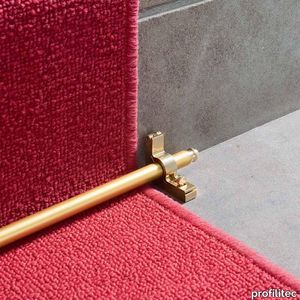
profilitec > Accessories
Round solid brass TTO TUBE for stair carpets Round brass tube profile to be used for fixing the stair runners. They can be applied with fixed or openable supports to facilitate cleaning.
Rectangular solid brass TTR TUBE for stair carpets
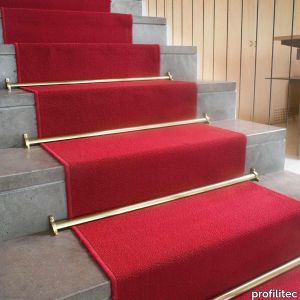
profilitec > Accessories
Rectangular solid brass TTR TUBE for stair carpets Rectangular brass profile for use in fixing the stair runners. They can be applied with openable supports to facilitate cleaning.
